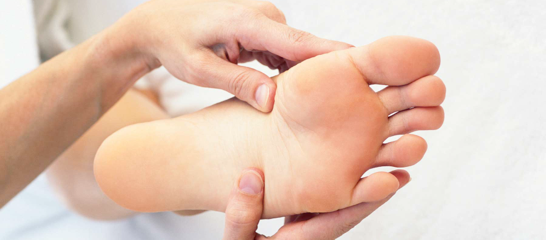




Treatment


Self-Care / Prevention
For Blisters
-
•Don’t break a blister. If it breaks on its own, apply an antibacterial spray or ointment and cover with a bandage or sterile dressing.
-
•Don’t cut away or pull off the broken blister’s loose skin. This protects the new skin below it.
For Bunions
-
•Don’t wear high heels or shoes with narrow toes.
-
•Wear sandals.
-
•Use moleskin or padding to separate overlapped toes.
-
•Try arch supports to reduce pressure.
-
•Use ring-shaped pads over a bunion.
-
•Cut out an old pair of shoes to wear in the house.
-
•Soak your feet in warm water.
-
•If needed, take an over-the-counter pain reliever as directed.
For Foot Cramps
-
•Stretch the foot muscles.
-
•Pull the foot back into a flexed position.
-
•Push the foot into the floor.
For Heel Spurs
-
•Use a cushion or heel cup under the heel.
-
•Do not jog or run. Avoid prolonged standing.
-
•Lose weight, if overweight.
-
•Roll a tennis ball under ball of the foot.
-
•Put ice on the heel for 10 minutes. Remove it for 10 minutes. Repeat many times.
-
•If needed, take an over-the-counter pain reliever as directed.
For Hammertoes
-
•Wear wide, roomy shoes.
-
•Massage the toes or get a foot rub.
-
•Change shoes during the day. Try athletic shoes.
-
•Use small pads over the center of the toe to lessen pressure.
For Injuries
-
•Use R.I.C.E.
-
•For an injured toe, tape it to the toe next to it. Do this for 7 to 10 days.
-
•Take an over-the-counter medicine to reduce swelling and pain as directed.
For Minor Infections
-
•Soak the foot in warm, soapy water for 20 minutes, 4 to 6 times a day. Pat the infected area dry. Use extra care if you have peripheral vascular disease. Make sure the water is not hot.
-
•Apply an over-the-counter antibiotic ointment, such as Neosporin. Cover with a sterile cloth or bandage.
For Morton’s Neuroma
-
•Wear wide shoes with soft insoles.
-
•Put pads or arch supports in your shoes. These help take pressure off the area.
-
•Take an over-the-counter medicine for pain as directed.
-
•See your doctor if the above measures don’t bring relief.
For Plantar Fasciitis
-
•Rest the foot as much as you can.
-
•Use R.I.C.E.
-
•Take an over-the-counter medicine for pain and swelling as directed.
-
•Wear shoes with a solid arch support.
For Plantar Warts
-
•Try salicylic acid plasters or other over-the-counter products, such as Wart-Off. Follow package directions.
-
•Use cushions in shoes.
-
•Wash your hands after touching warts to avoid re-infection.
-
•Wear sandals in the shower or public areas, such as pools.
-
•Do not pick at plantar warts.
To Help Prevent Foot Problems
-
•Wear shoes that fit well. Don’t wear shoes with pointed toes or ones that fit too tightly.
-
•Wash and dry your feet daily.
-
•Keep your feet moisturized.
-
•Inspect your feet daily for early signs of problems.
-
•Rest your feet by elevating them.
-
•Persons with diabetes and/or circulation problems need to take special care of their feet. Good foot care can prevent some foot infections. It may be necessary for a health care professional to cut the toenails.
{Note: If self-care measures do not help or if your foot problem gets worse, contact your doctor.}
Common Health Problems » Muscle & Bone Problems

Treatment depends on the type and how severe it is. In general, treatment includes:
-
•An exercise program, as needed. Exercises done in water are very helpful and soothing.
-
•Medicines to help relieve pain and reduce swelling. For gout, medicine to lower blood uric acid.
-
•Healthy diet. Weight loss, if overweight.
-
•Physical therapy.
-
•Surgery. When needed, damaged joints can be repaired or replaced with artificial ones.
Some foot problems are due to years of wear and tear on your feet. Others can be due to shoes that do not fit well or trimming your toenails too close to your skin. Circulation problems and diseases, such as diabetes, can lead to foot problems, too.

Signs & Symptoms
What It Could Be
What to Do




These problems appear in a matter of hours to a few days:
-
•The skin of your foot or toe is gray to black in color.
-
•You cannot feel sensation in your foot.

Gangrene.
Get medical care fast!

Pain from a fall or injury to your foot (not just a toe) with any of these problems:
-
•Severe bleeding.
-
•Your foot is misshaped.
-
•You can’t move your foot.
-
•Your foot looks blue or pale and is cold and numb.
-
•Your foot is so painful and/or swollen that you can’t put any weight on it.
Broken bone(s) in the foot (not just a toe).
Get medical care fast!See Broken Bones / Dislocations.

Sudden onset of pain in your feet and legs. The skin on your feet rapidly changes color: white, red, blue, grayish, or black.
Peripheral vascular disease.
Get medical care fast! See Frostbite & Hypothermia and Cold Hands & Feet.

Toes turn white then red in response to cold. Tingling. Numbness.
Frostbite (if signs occurs after cold exposure).
Contact doctor for an appointment right away.

The bottom of the foot is red and swollen and feels warm and tender.
Cellulitis.
See Cellulitis.

Cut or puncture from a dirty or contaminated object, such as a rusty nail or other object in the soil.
Cut or puncture wound.
See Skin Injuries/Wounds.

A foot wound with: Fever; redness, tenderness, or warmth; swelling; pain; and/or pus.
Infection.
See doctor.

Severe pain in foot joint, often the big toe. The pain is not due to an injury. The joint hurts a lot when anything touches it. The area is red, swollen, and tender.
Gout.
See doctor.

Joint pain and morning stiffness in joints that lasts more than 1 hour. Fatigue.
Rheumatoid arthritis.
See doctor.

Pain in only one toe after an injury to the toe.
Broken or sprained toe.

Open sores (ulcers) on the toes. Pain on the instep and cold, pale skin color which improves with rest.
Buerger’s Disease.
See doctor.

Tenderness and pain under the heel bone.
Heel spur.
See doctor.

Moist, soft, red, or gray-white scales on the feet, especially between the toes. Cracked, peeling, dead skin area. Itching. Sometimes small blisters on the feet.
Athlete’s foot.
See Athlete’s Foot.

White, brown, or yellow toenail. The nail can thicken, then get soft and weak. It may tear away from the nail bed or look deformed.
Toenail fungus.
See doctor.

Sharp and burning pain on the ball of the foot.
Morton’s neuroma. This is thickening of nerve tissue, usually between the third and fourth toes.
See Self-Care/Prevention– For Morton’s Neuroma below.

Painful growth on the ball or heel of the foot. Black pinholes or spots in the center.
Plantar wart.
See Warts.

Thickened skin on the ball or heel of the foot. Usually no pain.
Callus.
See Corns & Calluses.

Discomfort, pain, tenderness, and/or redness under the corner of a toenail and nearby skin.
Ingrown toenail.
See Ingrown Toenails.

The big toe points inward or outward. A bony bulge at side of the big toe. Thickened skin. Possible fluid build-up near the big toe. Stiffness or pain.
Bunion.
See Self-Care/Prevention– For Bunions below.

Thickened skin on tops of and between toes where rubbing is constant. Feels hard to the touch and looks round. Small, clear spot (hen’s eye) may appear in the center.
Corn.
See Corns & Calluses.

Pain between the heel and the ball of the foot. Often this is due to walking, running, or putting weight on the foot.
Planter Fasciitis. This is a problem with ligaments and tissues in the foot arch.
See Self-Care/Prevention– For Plantar Fasciitis below.

Red, sometimes fluid-filled sores caused by shoes that rub the foot.
Blisters.

Charley horse or muscle spasm in the foot. Often, this occurs at bedtime.
Foot cramp.
See Self-Care/Prevention– For Foot Cramps below.
Curled or claw-like position in a toe (usually the 2nd toe). A corn forms on the top of the toe. Pain.
Hammertoe.
See Self-Care/Prevention– For Hammertoes below.



2012 © All Rights Reserved - American Institute for Preventive Medicine | Disclaimer | Phone: 800.345.2476 | www.HealthyLife.com


